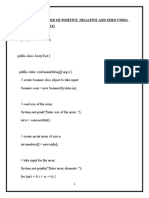0 ratings0% found this document useful (0 votes)
2 viewsimport java.util.Random;
The document contains a Java class named 'Numbers' that manages an array of integers with various functionalities. It includes methods for constructing the array, displaying elements, calculating the average, finding the maximum value, performing a linear search, tallying frequencies, and sorting the array. Additionally, it provides methods to display elements in reverse order and to list elements alongside their averages.
Uploaded by
gouraiahnagaCopyright
© © All Rights Reserved
Available Formats
Download as TXT, PDF, TXT or read online on Scribd
0 ratings0% found this document useful (0 votes)
2 viewsimport java.util.Random;
The document contains a Java class named 'Numbers' that manages an array of integers with various functionalities. It includes methods for constructing the array, displaying elements, calculating the average, finding the maximum value, performing a linear search, tallying frequencies, and sorting the array. Additionally, it provides methods to display elements in reverse order and to list elements alongside their averages.
Uploaded by
gouraiahnagaCopyright
© © All Rights Reserved
Available Formats
Download as TXT, PDF, TXT or read online on Scribd
You are on page 1/ 2
import java.util.
Random;
public class Numbers {
private int[] numbArray;
// 1. Constructs a default array of size 10
public Numbers() {
numbArray = new int[10];
numbArray[0] = 1;
numbArray[1] = 3;
numbArray[2] = 7;
numbArray[3] = 19;
numbArray[4] = 15;
numbArray[5] = 19;
numbArray[6] = 7;
numbArray[7] = 3;
numbArray[8] = 19;
numbArray[9] = 48;
}
// 2. Constructs an array of random numbers (min 0 - max 24) with array size
count
public Numbers(int count) {
Random random = new Random();
numbArray = new int[count];
for (int i = 0; i < count; i++) {
numbArray[i] = random.nextInt(25);
}
}
// 3. Prints all of the elements of the array in list form
public void display() {
for (int num : numbArray) {
System.out.print(num + " ");
}
System.out.println();
}
// 4. Prints all of the elements in reverse order
public void displayReverse() {
for (int i = numbArray.length - 1; i >= 0; i--) {
System.out.print(numbArray[i] + " ");
}
System.out.println();
}
// 5. Calculates and returns the average of all of the elements
public double average() {
double sum = 0;
for (int num : numbArray) {
sum += num;
}
return sum / numbArray.length;
}
// 6. Returns the maximum value of all of the elements
public int findMax() {
int max = numbArray[0];
for (int num : numbArray) {
if (num > max) {
max = num;
}
}
return max;
}
// 7. Returns the index number of the first instance of int lookFor, -1 if not
found
public int linearSearch(int lookFor) {
for (int i = 0; i < numbArray.length; i++) {
if (numbArray[i] == lookFor) {
return i;
}
}
return -1;
}
// 8. Prints the elements and their frequency
public void tallyList() {
int[] frequency = new int[50];
for (int num : numbArray) {
frequency[num]++;
}
System.out.println("Number\tFrequency");
for (int i = 0; i < frequency.length; i++) {
if (frequency[i] > 0) {
System.out.println(i + "\t" + frequency[i]);
}
}
}
// 9. Prints a column of numbers in the original order, reverse order, and
their average
public void listReverseAvg() {
System.out.println("LIST\tREVERSE\tAVERAGE");
for (int i = 0; i < numbArray.length; i++) {
int reverseNum = numbArray[numbArray.length - 1 - i];
double avg = (numbArray[i] + reverseNum) / 2.0;
System.out.println(numbArray[i] + "\t" + reverseNum + "\t" + avg);
}
}
// 10. Sorts the array in ascending order
public void sort() {
for (int i = 0; i < numbArray.length - 1; i++) {
for (int j = i + 1; j < numbArray.length; j++) {
if (numbArray[i] > numbArray[j]) {
int temp = numbArray[i];
numbArray[i] = numbArray[j];
numbArray[j] = temp;
}
}
}
You might also like
- Public Class Public Static Void Int: ArmstrongNo ratings yetPublic Class Public Static Void Int: Armstrong7 pages
- Rudra D. 100+ Java Programs Examples. Best For Beginners... 2023No ratings yetRudra D. 100+ Java Programs Examples. Best For Beginners... 202366 pages
- Design and Analysis of Algorithms Lab ManualNo ratings yetDesign and Analysis of Algorithms Lab Manual19 pages
- Laporan Resmi Algoritma Dan Struktur Data (Array)No ratings yetLaporan Resmi Algoritma Dan Struktur Data (Array)10 pages
- Class XI Sample Practical File ComputerNo ratings yetClass XI Sample Practical File Computer91 pages
- Regions Beyond Missions These-Thirty-Years - GuinnessNo ratings yetRegions Beyond Missions These-Thirty-Years - Guinness109 pages
- List of Master Circulars Issued by Railway Board100% (2)List of Master Circulars Issued by Railway Board10 pages
- Technical Data Sheet R 1234yf Gas Servei 1No ratings yetTechnical Data Sheet R 1234yf Gas Servei 13 pages
- Honeywell Generators - Transfer Switches - Commercial 100 400 AmpNo ratings yetHoneywell Generators - Transfer Switches - Commercial 100 400 Amp2 pages
- Ch17 - Additional Aspects of Aqueous EquilibriaNo ratings yetCh17 - Additional Aspects of Aqueous Equilibria12 pages
- 10 Deadly Martial Arts of The Ancient World - Ancient OriginsNo ratings yet10 Deadly Martial Arts of The Ancient World - Ancient Origins13 pages
- Enhanced Primary Care Pathway: Childhood CONSTIPATIONNo ratings yetEnhanced Primary Care Pathway: Childhood CONSTIPATION11 pages
- Hot Work Permit To Work Template Checklist - SafetyCulture PDFNo ratings yetHot Work Permit To Work Template Checklist - SafetyCulture PDF5 pages
- Lin-Manuel Miranda - Hamilton - Dear TheodosiaNo ratings yetLin-Manuel Miranda - Hamilton - Dear Theodosia8 pages
- Flexi Ul 1007 SC / Flexi Ul 1015 SC: Flexible Single-Core CableNo ratings yetFlexi Ul 1007 SC / Flexi Ul 1015 SC: Flexible Single-Core Cable2 pages
- Digestion, Nutrition, Metabolism - ANSWERNo ratings yetDigestion, Nutrition, Metabolism - ANSWER24 pages

























































































